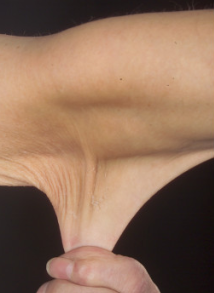Ehlers-Danlos Syndrome
Original Editors - Corey Vogt from Bellarmine University's Pathophysiology of Complex Patient Problems project.
Top Contributors - Corey Vogt, Eliza Clark, Megan Kanter, Admin, Lucinda hampton, Elaine Lonnemann, Kim Jackson, Laura Ritchie, Abbey Wright, Rosie Swift, 127.0.0.1, Blessed Denzel Vhudzijena and Wendy Walker - Your name will be added here if you are a lead editor on this page.
Introduction[edit | edit source]
Ehlers Danlos syndrome (EDS) is a group of hereditary connective tissue disorders which manifests clinically with skin hyperelasticity, hypermobility of joints, atrophic scarring, and fragility of blood vessels. It is largely diagnosed clinically, although identification of the gene encoding the collagen or proteins interacting with it is necessary to identify the type of EDS. It is important to identify the type of EDS to guide management and counseling[1][2]
Image: Hyperelastic skin in a person with Ehlers-Danlos syndrome.
Epidemiology[edit | edit source]
The incidence of Ehlers-Danlos syndrome, including all subtypes in the general population, is best estimated to be between 1 in 2500 and 1 in 5000[1]
- Hypermobility and classic subtypes are the most common with a prevalence of 1 per 10,000-15,000 and 1 per 20,000-40,000 respectively.
- EDS demonstrates equal prevalence amongst males and females of all racial and ethnic backgrounds. [2][3][4][5][6]
- There are other forms of EDS that are very rare. These include the arthrochalasia, kyphoscoliosis, dermatosparaxis, and vascular types. Currently, only 30 cases of the arthrochalasia and 60 cases of kyphoscoliosis have been reported worldwide.
- The vascular type is the rarest form, affecting about 1 in 250,000 people worldwide. [7]
Pathophysiology[edit | edit source]
The pathophysiology of most Ehlers Danlos syndrome subtypes involves heritable mutations in collagen synthesis and/or processing.
- The inheritance pattern of these mutations is variable, including autosomal dominant and recessive inheritance involving different mutations; there are reports of spontaneous mutations causing identical genotypes and phenotypes.
- The collagen affected by these mutations is integral to every body system, from the skin to the integrity of the vasculature, and as such, the symptoms of the disease can be variable and widespread.
Image 2: These 3 pictures depict 4 hypermobility traits: the ability to put hands in the "prayer" position behind the back, W sitting (sitting with knees bent and the legs splayed on either side), a double-jointed little finger, and the ability to touch the thumb to the wrist of the same hand.
Characteristics/Clinical Presentation[edit | edit source]
Patient presentations vary widely based on the respective underlying subtype. Ehlers-Danlos Syndrome contains at least six discernible phenotypes that are individually recognized. Each type contains characteristics similar to the others. Each specific type presents with the same general clinical characteristics that are a result of faulty or reduced amounts of Type III collagen in the body:[2][4][3][5][6][8] (Skin hyperextensibility and hyperflexible joints are two of the most common presenting signs of EDS).
- Cutaneous manifestations are the hallmark of Ehlers-Danlos syndrome: include hyperextensibility, smooth and velvet-like texture, fragility, delayed wound healing, and thin atrophic scars after wound healing.
- Common musculoskeletal manifestations include hypermobility leading to repeated subluxation and dislocation, which can lead to early osteoarthritis and chronic pain. This hypermobility may manifest as early as peripartum with hip dislocations in the newly delivered infant. Recurrent fractures may also be present.
- Other tissues are subject to friability due to the underlying collagen dysfunction, including both hollow and solid internal organs. They can be subject to both spontaneous and traumatic rupture or perforation. Additionally, hernias and rectal prolapse are common features.
- Classic facies include down slanting palpebral fissures, epicanthal folds, blue sclera, the appearance of premature aging, and micrognathia.
- Neurological manifestations include hypotonia, which may manifest in the developing child as delayed motor milestones such as walking. Generalized pain, insomnia, and chronic fatigue are also prevalent.
- Cardiovascular manifestations include mitral valve prolapse and, less commonly, tricuspid valve prolapse. Aortic root dilation is also a common feature that can lead to rupture without or without trauma. Other vessels, such as intracranial arteries, may be aneurysmal, predisposing them to rupture. Capillary fragility may manifest as easy bruising and bleeding without underlying bleeding diathesis[1].
- Chronic Pain may be present in patients with the Hypermobility Type of Ehlers-Danlos.[9]
Associated Co-morbidities[edit | edit source]
Many different medical conditions/disease states occur in individuals with EDS. Examples of co-morbidities include:[3][2][10]
- Gastroesophageal reflux
- Gastritis
- Irritable Bowel Sydrome
- Autonomic Dysfunction (neurally mediated hypotension, postural orthostatic tachycardia syndrome, paroxysmal supraventricular tachycardia)
- Aortic root dilatation
- Mitral valve prolapse
- Periodontal disease (friability, gum disease, gum recession)
- Temporomandibular Joint dysfunction
- Depression
- Developmental coordination disorder (in children)
Diagnostic Criteria[edit | edit source]
Clinical Examination and a detailed family history have proven to be the most effective means of accurately diagnosing EDS.
Major diagnostic criteria typically includes:[2][3][10]
- Joint hypermobility as indicated by a score of greater than or equal to 6/9 on the Beighton scale (Gold standard)
- Soft skin or skin hyperextensibility as defined by >1.5 cm on volar surface of forearm
- Fragile skin or significant skin/soft tissue abnormalities (easy bruising, delayed wound healing, atrophic scarring, easy tendon, ligament, vessel rupture)
Minor diagnostic criteria typically includes:[2][3]
- Positive family history
- Recurring joint subluxations/dislocations
- Chronic joint, limb, or back pain
- Altered blood pressure responses (neurally mediated hypotension or postural orthostatic tachycardia)
- Functional bowel disorders
- High, narrow palate
- Dental crowding
Laboratory Tests/Laboratory Values[edit | edit source]
Laboratory studies can be utilized as supporting evidence to confirm the diagnosis of a specific subtype of EDS.
Biochemical Studies can be used to analyze the make-up of collagen molecules in cultured skin fibroblasts and detect alterations to support a diagnosis of EDS:[2][3]
- Type IV EDS - Vascular
- Type VIIA and VIIB EDS- Arthrochalasia
- Type VIIC - Dermatosparaxis
Molecular testing utilizing DNA analysis can be used in diagnosis of EDS:[2][3]
- Type IV - Vascular
- Type VII - Arthrochalasia/Dermatosparaxis
Urinary Analyte Assay can be used in diagnosis of EDS:[2][3]
- Type VI - Kyphoscoliotic
Diagnostic Tests[edit | edit source]
CT scanning, MRI scanning, ultrasonography, electrocardiograms, and angiography are useful in diagnosing Type IV (Vascular) EDS with reports suggesting the presence of arterial aneurysms, arterial dissections, arterial ectasias, and arterial occlusions.[2][3]
Ultrastructural examination of collagen fibrils has been utilized as an assistive tool for diagnosis of Type I/II (Classical) EDS and Type VIIA/Type VIIB ( Arthrochalasia) EDS.[2][3]
Skin Biopsy using histopathologic analysis has yet to be proven as beneficial in the diagnostic process of EDS.[2][3]
Causes[edit | edit source]
EDS is classified as an inherited connective tissue disease. These patients’ tissues have greater amount of procollagen than normal and have a defect in the conversion of procollagen to collagen.[11] Three patterns of inheritance have been linked with the various subtypes of EDS: autosomal dominant, autosomal recessive, and X-linked (rarest form). The exact source of genetic mutation responsible for the condition is unknown. However, mutations in ADAMTS2, COL1A1, COL1A2, COL3A1, COL5A1, COL5A2, PLOD1, and TNXB genes have been linked to causation of EDS.[2][3]
- COL1A1, COL1A2, COL3A1, COL5A1, COL5A2 encode the manufacture of proteins that are responsible for multiple types of collagen
- ADAMTS2, PLOD1, and TNXB encode the manufacture of proteins that interact with or process collagen
Patients who have the vascular type EDS also lack type III collagen. Type III collagen is fibrillation forming collagen of 3 alpha-1 chains and is the most abundant type of collagen in the human body. In adults, it makes up the majority of the extracellular matrix in internal organs, especially the cardiovascular system and skin, resulting in arterial and vein complications. Sudden death has been reported in some cases.[12]
Systemic Involvement[2][3][13][10][edit | edit source]
Musculoskeletal
- Joint laxity manifesting as recurrent joint subluxations/dislocations due to minimal trauma and/or spontaneous onset. Joints involved typically include the vertrebral column, costo-vertebral, costo-sternal articulations, temporomandibular and joints of the extremities.
- Augmented biomechanics which results in less effective muscle contraction.
- Osteoarthritis resulting in early onset of degenerative joint disease. Early onset OA associated with increased mechanical stress placed on joints resulting from extreme ligamentous and articular laxity.
- Osteopenia due to reduction in general bone density. Precursor and predisposition to early onset of osteoporosis due to abnormally low bone density.
- Osteoporosis due to reduction in general bone bone density up to 0.9 standard deviations lowering than the average, healthy adult
- Scoliosis
- Kyphosis
- Chronic joint, ligament, tendon, or muscle pain due to myofascial and/or neuropathic source
- Headaches related to muscle tension in cervical spine and TMJ dysfunction
Neuromuscular
- Low muscle tone (hypotonia)
- Generalized muscle weakness-- more likely due to a muscle dysfunction than atrophy and muscle loss
- Decreased reflexes in the knee extensors and flexors seen in adolescents
Neurological
- Fatigue, pain and anxiety are often due to exhaustion of the CNS's reserves
- Migraines often disabling
- Chronic pain results from the tight link of peripheral biomechanic dysfunctions and CNS fatigue. This often leads to fear of movement that is aggravated with activity, ultimately leading to muscular deconditioning.
- Hyperalgesia is commonly seen in children and adults with hypermobility EDS due their central nervous system being highly sensitized
Cardiopulmonary
- Dysautonomia or Autonomic Dysfunction resulting in abnormal chest pain, palpitations at rest or with exertion, or abnormal blood pressure responses. Condition can be manifested as premature atrial complexes, paroxysmal supraventricular tachycardia, neurally mediated hypotension (NMH), or postural orthostatic tachycardia syndrome (POTS). Occurs in 33-50% of individuals with EDS, especially hypermobility and classic subtypes
- Aortic Root Dilation resulting in predisposition to arterial fragility or rupture. Typically occurs in a mild form in 25-33% of individuals with hypermobility and classic subtypes of EDS. Appears to be less severe than found in Marfan's Syndrome displaying no increased risk of dissection unless a prominent dilatation is present. Places individual at an increased risk for development of an abdominal aortic aneurysm (AAA).
- Mitral Valve Prolapse with increased risk of developing infective endocarditis
Gastrointestinal
- Functional Bowel Disorders (gastritis, irritable bowel syndrome, gastroesophageal reflux) occur in up to 50% of individuals with EDS
- High prevalence of GI reflux abdominal pain, constipation and diarrhea in adolescents with hypermobility EDS
Integumentary
- Hyperextensibility of skin
- Fragility of soft tissue resulting in increased likelihood of rupture or tearing of internal organs
Genitourinary
- Uterine Fragility
- Premature rupture of fetal membranes during pregnancy
- Pelvic prolapse
- Dyspareunia
- Urinary incontinence often seen in adolescents with Type III
Oral/Dental
- Periodontal disease resulting in friability, gingivitis, and gum recession
- Presence of a high, narrow palate combined with dental crowding
Hematologic
- Easy bruising
- Prolonged bleeding times, epistaxis, and menometrorrhagia
Psychiatric
- Depression
Management[edit | edit source]
Any provider caring for a patient with Ehlers-Danlos syndrome should be aware of the multitude of complications of the disease and potential preventative measures. Treatment and management of patients with EDS should use a multidisciplinary approach that focuses on the prevention of disease progression and subsequent complications as there is no cure for the disease. Specialists generally manage specific care within the field of which the patient has concerning pathology. eg.the monitoring of cardiovascular concerns will be by a cardiologist; likewise, musculoskeletal pathology is monitored and treated by an orthopedist; geneticist or family medicine provider acts as the primary provider referring the patient to these specialists[1]
Treatment of EDS typically consists of management of specific signs and symptoms of the condition as well as lifestyle adjustments to prevent injury/complications. These include:
Education
- Avoidance of high impact activities that place increased stress on pre-morbid lax joints, such as heavy lifting or resistance training
- Avoidance of activities that require joint hyperextension, such as excessive stretching or repetitive activities
- Meticulous skin care
- Meticulous dental care
- Frequent medical check-ups for vascular dysfunction associated with Vascular EDS, bone density (DEXA scans), or orthopaedic dysfunctions associated with increased joint laxity and low muscle tone
Occupational Therapy
| [14] |
- Bracing/splinting in combination with orthopaedists, rheumatologists, and physical therapists to promote increased joint stability and decrease likelihood of joint subluxation/dislocation, especially in upper extremity joints and vertebral joints
Ophthalmologist
- Consultation to screen for myopia, retinal tears, and keratoconus common in individuals with EDS
Dentist
- Consultation to screen for periodontitis and to emphasize importance of meticulous dental care in individuals with EDS
Surgical/Invasive Procedures
Surgical and/or other invasive procedures are not necessarily recommended in patients with EDS as a means of primary treatment due to the impaired wound healing, increased likelihood of scarring, and increased likelihood of blood vessel rupture associated with EDS. However, certain subtypes of EDS, most notably the classic and vascular subtypes of EDS possess an increased predisposition to surgical complications compared to the others.
| [15] |
Physical Therapy Management[edit | edit source]
PT's "play an important role in management through exercise prescription and patient education for many of these conditions.[17].Each physical therapy plan of care must be specially created for the patient depending upon the subtype of EDS and the signs and symptoms of that patient.
In general, physical therapy intervention focuses on decreasing the patient’s disability from a multidirectional approach.
- Exercise program consisting of aerobic conditioning combined with a low resistance, high repetition resistive training program to promote increased joint stability by increasing general resting muscle tone
- Assistive devices to provide loading relief to lower extremity joints during ambulation and weight bearing activities
- Bracing to promote increased joint stability and decrease likelihood of joint subluxation/dislocation
- Pain management techniques to address soft tissue, myofascial, and chronic joint pain associated with EDS
- Safe, effective, efficient transfers to avoid excessive weight bearing or loading of lower extremity joints.
More detailed description of interventions below:Resistance training: to avoid recurrent joint subluxations/dislocations due to increased muscle tone and to counteract presence of excessive joint, ligament, tendon, and muscle laxity
- Low resistance, high repetition activities
- Goal is to improve static and dynamic muscle tone to promote increased joint stability during weightbearing and functional activities
- Incorporate core stabilization exercises early rehab and progress throughout
- Prevent excessive loading through weight bearing joints
- Avoid excessive use of involved joints for heavy lifting
- Strengthening the shoulder girdle is important in patients with kyphoscoliosis.
- Past studies have shown that strengthening the knee in the full hypermobile range rather than just the neutral range is more beneficial to improve strength, pain, and impaired function.
Proprioceptive Exercises
- Closed kinetic chain exercises
- Balance
- Plyometric training
Aerobic training
- Walking
- Bicycling
- Low-impact aerobics and/or water aerobics
- Swimming
- Goal is to promote increased static and dynamic muscle tone to prevent acute joint subluxations/dislocations by minor trauma or stimulus
- May function as pain relief mechanism for individuals experiencing chronic joint and muscle pain associated with EDS
Myofascial release techniques
- Pain relief (immediate - several hours)
- Allows pain free participation in resistance training or daily activities
- Goal is to reduce the presence of muscle spasms that result in intense pain in muscles and surrounding ligaments, tendon, and joints
Modalities
- Hot/cold pack
- Massage
- Goal is to provide pain relief to the patient, who may/may not be experiencing chronic muscle and joint pain from frequent joint subluxations/dislocations, myofascial spasms, and trigger points associated with EDS
Adaptive Equipment
- Wheelchair/scooter
- Walker/Crutches/Cane (should be used with caution and discretion due to increased weight bearing through upper extremities with use)
- Modified eating utensils (prevents excessive strain placed on small joints of hands and fingers)
- Modified writing utensils (prevents excessive strain placed on small joints of hands and fingers)
- Modified sleeping surface (air mattress, viscoelastic foam mattress, pillow mattress)
- Goal is to allow daily functioning and promote increased quality of life by decreasing pain or chance of joint subluxation/dislocation.[18][19][2][3][13][20][10][21]
Outcome Measures[edit | edit source]
There is currently not adequate research for specific EDS outcomes. However, these are some of the suggested assessment tools used to measure progress of impairments in this population. It is possible many different measurements could be used that focus on balance, gait speed, cadence, dual-task activities, quality of life, and fear of falling.
- Activities-specific Behavior Confidence
- Falls Efficacy Scale
- mCTSIB
- DGI/FGA
- Multidimensional Fatigue Symptom Inventory
Differential Diagnosis [edit | edit source]
Include, not limited to:
- Marfans Syndrome
- Loeys-Dietz Syndrome
- Stickler Syndrome
- Williams Syndrome
- Aarskog-Scott Syndrome
- Fragile X Syndrome[3]
- Patients with EDS, especially those with EDS hypermobility type, are often misdiagnosed with conditions such as fibromyalgia, chronic fatigue syndrome, or depression, given the overlap of symptoms and the psychosocial impact they have on the patient[1]
Case Study[edit | edit source]
Ehlers-Danlos_Syndrome_Case_Study
Resources[edit | edit source]
Ehlers-Danlos National Foundation: www.ednf.org
Ehlers-Danlos Syndrome Network C.A.R.E.S.: http://www.ehlersdanlosnetwork.org/
References[edit | edit source]
- ↑ 1.0 1.1 1.2 1.3 1.4 Miklovic T, Sieg VC. Ehlers danlos syndrome.2020 Available from: https://www.ncbi.nlm.nih.gov/books/NBK549814/( last accessed 22.2.2021)
- ↑ 2.00 2.01 2.02 2.03 2.04 2.05 2.06 2.07 2.08 2.09 2.10 2.11 2.12 2.13 2.14 2.15 Steiner RD. Ehlers-Danlos Syndrome. http://emedicine.medscape.com/article/943567-overview (Accessed Feb 15, 2010).
- ↑ 3.00 3.01 3.02 3.03 3.04 3.05 3.06 3.07 3.08 3.09 3.10 3.11 3.12 3.13 3.14 3.15 Levy HP. Ehlers-Danlos Syndrome, Hypermobility Type. Gene Reviews. http://www.ncbi.nlm.nih.gov/bookshelf/br.fcgi?book=gene&part=eds3 (Accessed Feb 16, 2010).
- ↑ 4.0 4.1 Wenstrup R, Paepe AD. Ehlers-Danlos Syndrome, Classic Type. Gene Reviews. http://www.ncbi.nlm.nih.gov/bookshelf/br.fcgi?book=gene&part=eds (Accessed Mar 3, 2010).
- ↑ 5.0 5.1 Yeowell HN, Steinman B. Ehlers-Danlos Syndrome, Kyphoscoliotic Form. Gene Reviews. http://www.ncbi.nlm.nih.gov/bookshelf/br.fcgi?book=gene&part=eds6 (Accessed Mar 3, 2010).
- ↑ 6.0 6.1 Pepin MG, Myers PH. Ehlers-Danlos Syndrome, Vascular Type. Gene Reviews. http://www.ncbi.nlm.nih.gov/bookshelf/br.fcgi?book=gene&part=eds4 (Accessed Mar 3, 2010).
- ↑ Ehlers-Danlos syndrome. Genetics Home Reference. 2017. Accessed March 2017. Available from: https://ghr.nlm.nih.gov/condition/ehlers-danlos-syndrome#statisticshttps://ghr.nlm.nih.gov/condition/ehlers-danlos-syndrome#statistics
- ↑ Voermans N, Knoop H, van de Kamp N, Hamel B, Bleijenberg G, van Engelen B. Fatigue Is a Frequent and Clinically Relevant Problem in Ehlers-Danlos Syndrome. 2010;30(3):267-274
- ↑ Rombaut L, Scheper M, De Wandele I, De Vries J, Meeus M, Malfait F, Engelbert R, Calders P. Chronic pain in patients with the hypermobility type ofEhlers-Danlos syndrome: evidence for generalized hyperalgesia. Clin Rheumatol.fckLR2014 Feb 4
- ↑ 10.0 10.1 10.2 10.3 Woinarosky N et al. The evidence-based rationale for physical therapy treatment of children, adolescents, and adults diagnosed with joint hypermobility syndrome/hypermobile Ehlers Danlos syndrome. American Journal of Medical Genetics Part C: Seminars in Medical Genetics, 2017;175(1):158-167.
- ↑ P.H. Byers, M.L. Murray. Heritable collagen disorders: the paradigm of the Ehlers-Danlos syndrome. J Invest Dermatol, 2012;132(3): E6–E11
- ↑ Liu X, Wu H, Byrne M, Krane S, Jaenisch R. Type III collagen is crucial for collagen I fibrillogenesis and for normal cardiovascular development. Proceedings of the National Academy of Sciences.1997;94(5):1852-1856.
- ↑ 13.0 13.1 Castori M, Morlino S, Celletti C, Celli M, Morrone A, Colombi M, Camerota F, Grammatico P. Management of pain and fatigue in the joint hypermobility syndrome (a.k.a. Ehlers–Danlos syndrome, hypermobility type): Principles and proposal for a multidisciplinary approach. Am J Med Genet Part A, 2012;158A(8):2055–2070.
- ↑ Bennett Bremner. Spiral Thigh Brace for Ehlers Danlos Syndrome. Available from: http://www.youtube.com/watch?v=LWNiI-YyfE0 [last accessed 27/09/13]
- ↑ caringmedical. Prolotherapy for Hypermobility and Ehlers-Danlos. Available from: http://www.youtube.com/watch?v=6iC7s3sMujc [last accessed 27/09/13]
- ↑ Bathen T, Hångmann AB, Hoff M, Andersen LØ, Rand-Hendriksen S. 2013. Multidisciplinary treatment of disability in Ehlers–Danlos syndrome hypermobility type/hypermobility syndrome: A pilot study using a combination of physical and cognitive-behavioral therapy on 12 women. Am J Med Genet Part A. 2013; 161A(12):3005–3011.
- ↑ Engelbert RH, Juul-Kristensen B, Pacey V, de Wandele I, Smeenk S, Woinarosky N, Sabo S, Scheper MC, Russek L, Simmonds JV. 2017. The evidence-based rationale for physical therapy treatment of children, adolescents, and adults diagnosed with joint hypermobility syndrome/hypermobile Ehlers Danlos syndrome. Am J Med Genet Part C Semin Med Genet 175C:158–167.
- ↑ Russek LN. Examination and Treatment of a Patient with Hypermobility Syndrome. Physical Therapy 2000;80(4):386-398.
- ↑ Russek LN. Hypermobility Syndrome. Physical Therapy 1999;79(6):591-599.
- ↑ Yeowell HN, Steinmann B. Ehlers-Danlos syndrome, kyphoscoliotic form. NCBI, 2013. Available from: https://www.ncbi.nlm.nih.gov/books/NBK1462/?report=printable
- ↑ Ferrell W, Tennant N, Sturrock R, Ashton L, Creed G, Brydson G et al. Amelioration of symptoms by enhancement of proprioception in patients with joint hypermobility syndrome. Arthritis & Rheumatism. 2004;50(10):3323-3328.










